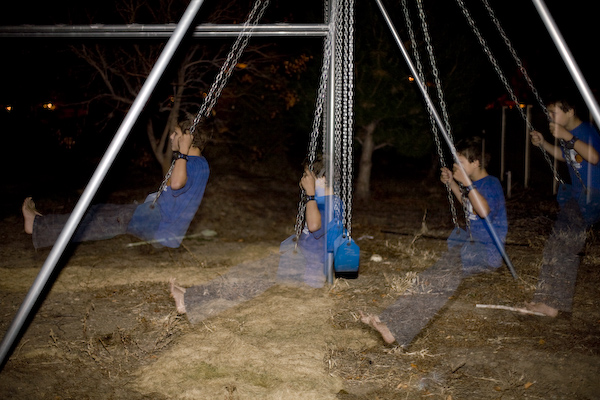Strobes and Slow Shutterspeeds
Several months ago I presented an image of hands on a piano, captured with multiple flashes in a single, long exposure. This week I show a somewhat higher-tech application of the same basic idea, but with some enhancements of more modern technology, and a slightly different goal.
The set-up was fairly simple: a camera with a fast (f/1.4) lens set on a tripod, with a flash mounted on the camera. The camera was manually set with the shutter at 1s and the aperture, (after some experimentation), at f/1.8. The flash (a Canon 580 EX) was also set manually, to 1/128th power, and a true strobe effect was achieved by setting the strobe frequency to 3 Hz (3 flashes per second). Using a “modeling light” capability in the flash (where it flashes at an high frequency for a second or so), I was able to cast enough light on the subject that I could manually focus the lens.
There were a few surprises for me, and that led to some experimentation. First, I thought I was going to need a much higher frequency on the strobe. I started with 20 Hz and ended up with highly overlapping images of this young swinger — so many, in fact, that it was hard to discern any single instance. I settled on 3 Hz because that gave me distinct (non-overlapping) instances of the subject in motion. Second, I had expected that, with a frequency of 3 Hz for a 1s exposure, I would have recorded 3 flashes during the exposure instead of the 4 that are in the above image. Third, 1/128th power proved sufficiently powerful for this scene — that’s 7 f-stops less light than the maximum this flash can produce!
This tool of using multiple flash bursts during a single exposure can be very useful for showing motion in a still image — especially motion along a well-defined path. Whereas the hands on a piano shot had irregular flashes during the exposure in order to capture the subject in particular positions, the strobe effect with regularly spaced flashes helps convey the movement of an object along a path. Having the movement confined to a plane perpendicular to the lens enabled me to focus once and have that work for the entire exposure as the subject-to-camera distance remained fairly constant. Keeping the camera on a tripod eliminated camera movement, so the background is perfectly registered through all of the individual flashes. Shooting at 1/64th or 1/32nd power would have enabled me to shoot at a smaller f-stop, and that would have given me a little more depth-of-field, being a little more forgiving of the errors from the manual focus, but that would have taxed the flash further, producing shorter bursts of strobing and longer flash-recycle times.
The special strobe capability of the Canon flash used here is not found in many flashes, but the effect can be closely duplicated with a manual flash-firing button found on many flashes. You will want to take the flash off the camera so that pushing the button on the flash doesn’t cause movement in the camera during the exposure. Also, setting the flash to a manual and low output (such as the 1/128th power) will allow you to get several flashes in a short time, as each individual burst requires relatively little stored energy.

Tip of the Week
2007.11.05

